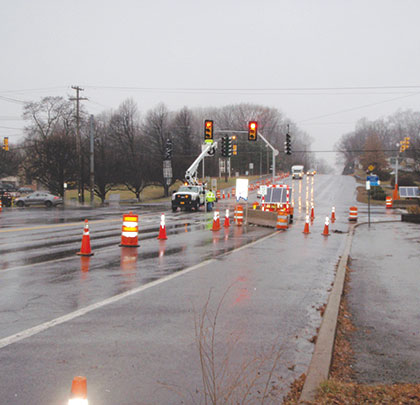The corner of East Chester and Flatbush is one of the busiest intersections in the City of Kingston, New York. Nearly 20,000 vehicles pass through the intersection every day, including the many tourists who visit the city—the first capital of New York State—to take advantage of its nearby hiking and biking trails, rock-climbing, skiing, boating, and entertainment. So when the city’s signal lights controlling traffic failed, it was no small matter for city engineer, Ralph Swenson, to solve quickly.
“The signal light controller is more than 30 years old,” Swenson reports. “It had already been identified for the city’s capital replacement budget. We recognized a number of deficiencies in the system, compared to today’s standards, and budgeted a full redesign to correct them. But the controller failed before the project got under way.”
LONG-TERM PLANNING
Swenson determined that the best road forward, in the long-term, would be to redesign the intersection to ensure that current standards will be met with the new installation. The old system had insufficient vertical clearances and only 8-inch diameter lenses versus today’s standard of 12-inch diameter lenses. For these and other reasons, an engineering firm was engaged to complete a redesign to Federal Highway Administration Standards. Advertisement for bids was expected to be issued in late March, with construction slated for summer/fall 2015.
In the meantime, however, the city required an interim solution to keep traffic moving.
“I did some research and North America Traffic came to my attention quickly,” says Swenson. “I found they were ready to supply the signals we needed in a timely fashion. They went right to the top of the list.”
Now celebrating 20 years in the traffic signals business, North America Traffic Inc. (NAT) pioneered the development of trailer-mounted, solar-charged, battery powered systems for temporary installations on roadbuilding and construction sites. And although Swenson was up against an urgent need, the purchase of the new system would still have to undergo proper tender and bidding procedures. “We located two competitive sources in this region and requested quotes. As it turned out, North America Traffic was also our lowest cost bidder.”
QUICK RESPONSE
NAT soon delivered four of its PTL 2.4x dual head signal systems to Kingston, covering all four directions of traffic across all lanes. Originally, the firm requested 2 weeks’ lead time. The company, however, according to Peter Vieveen, president of North America Traffic, was confident in their product and their pricing and went ahead with production of the units as the city completed its purchase process. Once the order went through, NAT was able to deliver the four units within 1 week—just in time for Christmas shopping.
With independent programs for the two dual heads on each unit, the PTL 2.4x is able to control traffic for both the left turning lane and the through lane. Swenson restricted the road’s three lanes down to two. “The right lane closure had minimal impact on the traffic flow. We get queues building up for right turns during rush hour, but the intersection is still cleared within a few cycles.”
Kingston mayor Shayne Gallo concurs. “Overall, the intersection is still handling 90 percent of its previous capacity,” he says. “The portable signals are certainly more economical than having police officers direct traffic.”
A SIMPLE SOLUTION
NAT field service staff accompanied the new units to instruct Swenson’s supervisors on how to configure the lights. The four signal sets synchronize automatically, as any one of the units can be designated as the master. Programming can be completed through a single remote control. With it, Kingston’s Public Works Staff can update the sequencing of the signals in accord with seasonal traffic patterns or to meet short-term needs. NAT also maintains a 24/7 hot line for technical support to the Kingston crew.
The extreme cold of this winter season could have been a factor in the signals’ solar power system, but external chargers are used to refresh the heavy-duty batteries only once every couple of weeks. As temperatures return to normal and hours of daylight increase, the solar arrays will fully sustain the systems’ power supply.
USEFUL ASSETS
Once the project is complete and the permanent signals are installed, the portable units will remain in Kingston’s Public Works fleet. Swenson notes: “We decided to buy instead of rent these signals because of the length of the total project. Our Department of Public Works will make use of the portable signals anytime they need a temporary detour. They will be helpful for any kind of paving or sewer work, and we can also offer them for use to other municipalities in the area to rent. They will always be a useful asset for the City.”
ABOUT NORTH AMERICA TRAFFIC INC.
North America Traffic was launched as R.C. Flagman in 1993 when Peter Vieveen built the world’s first Remote Controlled Flagman™ out of his garage. At the time, Mr. Vieveen was a senior estimator in the construction industry with more than 25 years of construction experience. Being able to think like a contractor, he understood the importance of reducing costs while increasing safety. North America Traffic now operates a full production facility and its products have been used on more than 3,000 projects across North America. Today, the company is the world leader in traffic control systems, with eight different models of portable traffic signals, flashing beacons, and flagging systems to meet all traffic control needs. ■
For More Information: For more information about North America Traffic products and services, visit www.northamericatraffic.com.
_________________________________________________________________________
Modern Contractor Solutions, June 2015
Did you enjoy this article?
Subscribe to the FREE Digital Edition of Modern Contractor Solutions magazine.

The Interim Solution


